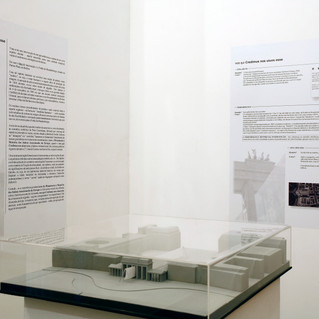nos qui Credimus nos uiuos esse?
nós, que nos acreditamos vivos ?
wir, die wir uns lebendig glauben?
we, that belive us alive?
"Pariser Platz, Berlim. No centro histórico, simbólico da capital dos alemães, contra o ocre, o cinza das fachadas e o colorido difuso das ruas, carros e pessoas, várias bandeiras numa bandeira de algodão, branca, de quinze metros de altura por cento e vinte e cinco metros de comprimento, atravessa o vão central do Portão de Brandenburgo, cortando a praça de uma extremidade à outra. Sobre ela, as imagens de corpos, mil corpos numa espécie de grande monotipia em carvão; marcas, registros no pano branco, 20 anos de queda do muro."
"Pariser Platz, Berlin. Im historischen und symbolträchtigen Zentrum der deutschen Hauptstadt, gegen das Ocker, das Grau der Hausfassaden und das diffuse Bunt der Straβen, Autos und Menschen, überquert eine aus tausenden verschiedenen Stofffahnen zusammengenähte fünfzehn Meter breit und hundert fünf und zwanzig Meter lange Stoffbahn die Länge des Pariser Platzes und durschneidet die Mitte des Brandenburger Tors. Auf ihr bilden tausend Körper eine Art monotypischer Zusammenstellung mit Kohle; Abdrücke deutscher Bürger auf den weiβem Stoff, 20 Jahre nach dem Fall der Berliner Mauer."
“In the historic center, symbolic of the capital of the Germans, against the ocher, the gray of the facedes and the diffused color of streets, cars and people, several flags on a white cotton flag, fifteen meters high by one hundred and twenty-five meters long, crosses the central span of the Brandenburg Gate, cutting the square from one end to the other, over it the images of bodies, a thousand bodies in a kind of large monotype in charcoal, marks, imprints on the white closs, 20 years of the fall of the Wall. "
Paulo Rubens da Rocha Sampaio












©MARCOS MORTEIRA

